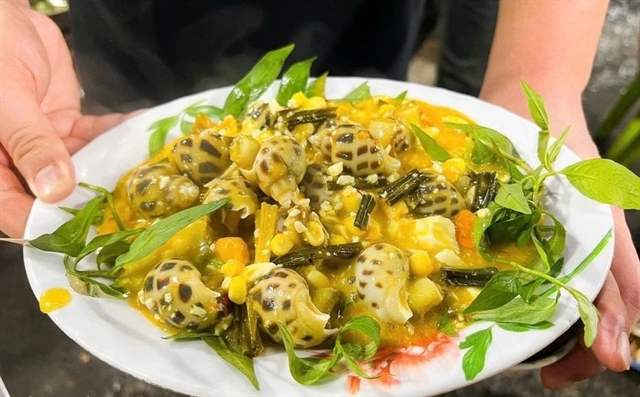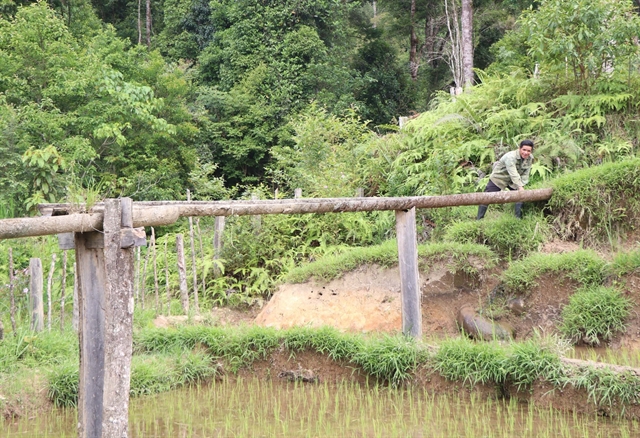 Society
Society

 |
| People use đùng đình trees to make water pipelines. — VNA/VNS Photo Cao Nguyên |
Cao Nguyên
KON TUM — In the Central Highlands province of Kon Tum, numerous locations are wrestling with water scarcity, resorting to a myriad of conservation methods. Yet, in stark contrast, the secluded commune of Ngọk Yêu in Tu Mơ Rông District is comfortably self-sufficient, thanks to a robust irrigation system.
This achievement is not without effort; it represents the diligent toil of the indigenous Xê Đăng people residing in the commune. They have successfully erected a number of irrigation structures, cleverly tailored to suit their local topography and weather conditions, thereby enabling them to surmount their challenges.
These irrigation endeavours have had a transformative effect on their lives, which continue to change incrementally with each passing day.
The commune of Ngọk Yêu is composed of seven villages, home to a population of nearly 1,700 people, among them up to 98 per cent are of Xê Đăng ethnicity.
The commune proudly boasts 28 irrigation systems of varying sizes, ensuring an ample water supply for hundreds of hectares of rice fields.
Among their self-made irrigation works, the Đắk Kring irrigation project in Long Láy 2 Village is the largest. It can supply water for eight hectares.
On the vast eight-hectare expanse, two depressions in the terrain necessitate the construction of independent water pipelines, according to local inhabitants.
A Thoát, the leader of Long Láy 2 Village, said the ditches at these sunken locations are fortified with pillars hewn from tree trunks. The water conduits measure about 25cm in width, extending roughly 20 to 30m in length.
"We procure đùng đình trees [scientifically known as Caryota mitis] from the forest, hollow them out to channel water from the mountains to our fields. During the rainy season, landslides are common, hence locals undertake to clear out these pipelines," he said.
A Dom, another resident, said: "Our rice cultivation area is rather limited, so we use nearby streams for sowing. As natural water supply can be inconsistent - abundant at times, scarce at others - irrigation becomes vital for a stable water source."
"Initially, it's an arduous task, but once the irrigation system is in place, the workload diminishes considerably."
The local people ingeniously utilise timber from the forest and stone from the stream to construct these irrigation structures.
This effort, Dom said, has facilitated the thriving growth of rice in the commune.
Alongside the Đắk Kring irrigation project, the inhabitants of Long Láy 2 Village have also engineered four additional irrigation structures, collectively capable of watering more than 12ha of land.
Lê Văn Hoàng, chairman of the Ngọk Yêu Commune People's Committee, shared that of the 28 irrigation systems in the commune, 19 were constructed by the villagers themselves, serving to irrigate nearly 70ha of rice fields.
Given the region's undulating topography, characterised by hills and mountains, extensive rice fields are a rarity in the commune. The arable land is often fragmented and small, necessitating local efforts for irrigation, even with state support.
Similar to Đắk Kring, other self-constructed irrigation systems within Ngọk Yêu Commune are small dams, complete with pipelines made from earth.
Joint efforts
 |
| Irrigation work brings enough water to rice fields. — VNA/VNS Photo Cao Nguyên |
To ensure the longevity of these irrigation structures and to assist the residents in stabilising their agricultural production, the commune authorities have provided materials for the repair and reinforcement of these works.
"People undertake the construction of irrigation systems, while the commune authorities oversee, inspect, and provide support during repair work, ensuring the safety of these structures and giving people confidence in their farming," Hoàng said.
Beyond providing gabions for the dam base and landslide-prone areas, the commune authorities have also invested in large-diameter plastic pipes to supplant soil pipelines, thereby mitigating the potential impact of landslides.
These plastic conduits, some of which span kilometres, channel water to the irrigation areas.
Additionally, the Tu Mơ Rông District authorities are laying out plans to reinforce canals, supplementing the efforts of the locals in maintaining their irrigation systems.
Phạm Xuân Quang, the deputy chairman of the district People's Committee, acknowledged that irrigation projects often necessitate substantial investment. Consequently, when local residents undertake such initiatives themselves, the district consistently fosters an encouraging environment and facilitates their deployment.
As for works that are not structurally sound, or those required to cover expansive irrigation areas, the district dispatches survey teams. The findings from these assessments are then incorporated into the national target programme aimed at strengthening canals and building irrigation systems.
The Đắk Kring irrigation project has already been surveyed and is slated for investment to enhance its structural integrity and robustness.
"Alongside state-funded schemes, the Xê Đăng people's own irrigation efforts have been instrumental in sustaining rice cultivation and ensuring food security," Quang pointed out.
Beyond a focus on irrigation, local authorities have, in recent years, also spurred the Xê Đăng people of Ngọk Yêu Commune to diversify their agricultural endeavours, promoting the growth of industrial crops for higher productivity and efficiency.
The commune's inhabitants have cultivated a significant area of approximately 224ha with coffee plants. The crop has grown to become a crucial asset in their efforts towards poverty alleviation.
Recognising the economic advantages of coffee cultivation, the local people are progressively transitioning from rice and cassava farming to coffee production, a shift that has not only stabilised their lives but also augmented their income. Last harvest yielded over 500 tonnes of fresh coffee across the entire commune.
Both district and commune authorities are actively advocating for and facilitating the development of medicinal plants, particularly the cultivation of Ngọc Linh ginseng. Over the years, the Tu Mơ Rông District has solicited the assistance of numerous businesses to provide the locals with Ngọc Linh ginseng seedlings.
The chairman of the Ngọk Yêu Commune People's Committee, Lê Văn Hoàng, disclosed that the cultivation of Ngọc Linh ginseng has had the positive side effect of curbing deforestation. The focus has shifted towards preserving the forest to create suitable land for ginseng cultivation.
"In recent years, households in Ngọk Yêu Commune have not sought poverty support during the intercrop period. Basic food security has been maintained. This accomplishment can be attributed to the adequate water supply in rice fields. Presently, local residents proactively manage their production to enhance their living standards," he said. VNS




